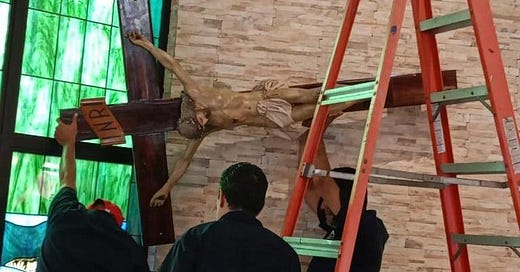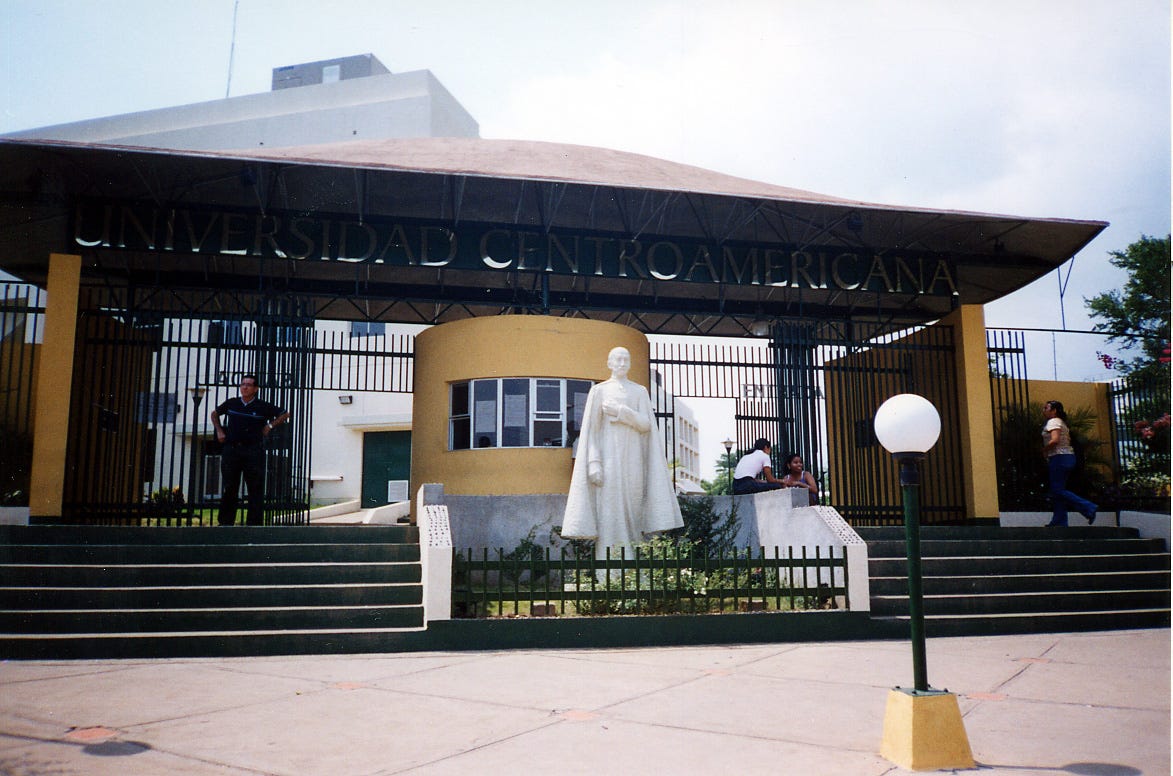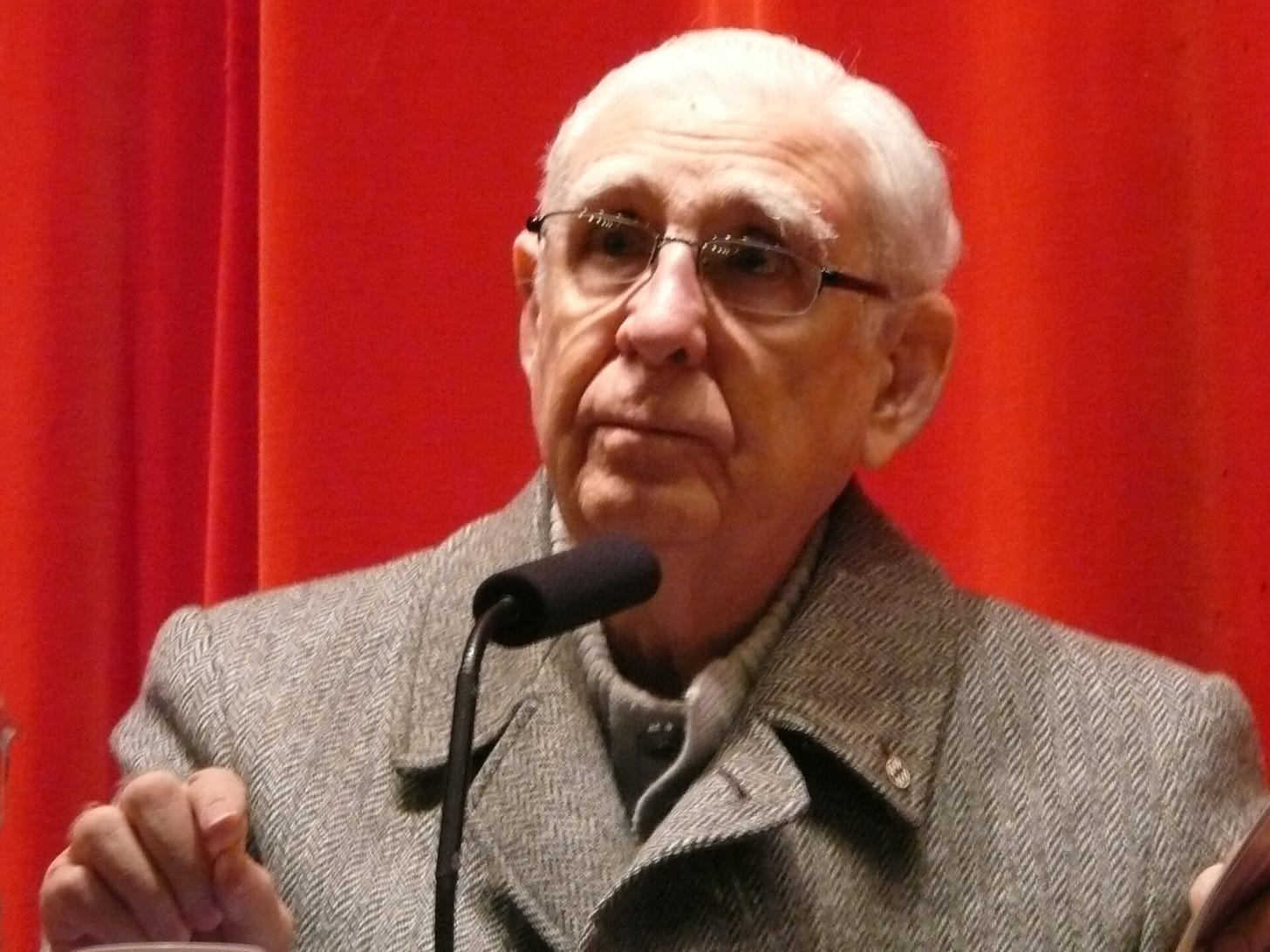
Jesuits face crackdown, after long history with Nicaragua's Ortega
When Daniel Ortega seized power in 1979, Jesuits were by his side. Now the Society of Jesus could be expelled from Nicaragua.
Nicaragua’s government announced Aug. 23 that the legal identity of the Society of Jesus in the country had been officially revoked. The dissolution includes the seizure of all assets and properties of the Jesuits in the country and, potentially, the expulsion of the order’s members.
A local source told The Pillar that members of the order could be notified within days, or even hours, of their expulsion from the country by migration authorities — even Jesuits who are Nicaraguan nationals might be deported, sources say.
“The dictatorship doesn’t care if they have a Nicaraguan passport. In they past, they have expelled Nicaraguan nationals from the country, so that won’t stop them,” a source close to the order explained.
The move comes after more than a dozen Jesuits were dispatched from their home in Nicaragua last week — with some forced into exile — after the Jesuit-run University of Central America in Nicaragua learned Aug. 15 that its property had been seized by the government, on charges that the university was aiding terrorism and treason.
The university is the fourth Catholic college in Nicaragua to be taken over by the country’s government in recent months, and — as one of the largest and most prestigious universities in the country — was also the epicenter of a student protest movement in 2018 and 2019, pushing back against the government of Nicaragua’s President Daniel Ortega.
The seizure of the university and the revocation of the Jesuits’ legal identity, represent a long shift for the Society of Jesus in Nicaragua — now treated as enemies of the state, Jesuits were vocal supporters of Daniel Ortega when he took power in 1979, amid the country’s "Sandinista Revolution."
So how did the Society of Jesus go from a position “support, but criticism” toward the Sandinista Revolution in 1979 — a Fr. Pedro Arrupe put it — to seeing its prominent institutions confiscated in Nicaragua?
The accusations
The official journal of the Nicaraguan state announced Aug. 23 that the legal entity owning Jesuit assets in Nicaragua had been canceled by the government, allegedly because the order had not reported its financial records to the government in recent years.
Nicaragua’s interior ministry has ordered the seizure of all Jesuit assets and houses in the country. The government is expected to seize Jesuit schools as well,, including the rural network of Fe y Alegría schools, geared toward the children of working-class families — even while local media report report that the future status of these schools is unclear as some of them have their own legal personality, and the school officials say they have not received any notifications from authorities.
An order to seize the University of Central America’s assets was issued last week by Judge Gloria Saavedra, known for handling the cases of priests imprisoned and later exiled in Nicaragua, including Father Óscar Benavidez, sentenced to more than 10 years in prison and later released by the regime.
Saavedra, a graduate of the Central American University — the UCA — charged in a bench order that the university "functioned as a center of terrorism, taking advantage of the conditions created with lies, to raise the levels of violence and destruction, organizing armed and hooded criminal groups."
Those groups, she said "they terrorist methods" and "destroyed public universities, public and private buildings."
Likewise, she said, they committed “criminal activities with firearms, lethal ammunition, mortars, Molotov cocktails, and blunt objects, causing considerable economic loss to the country.”
But legal experts in the country have noted that the order reads like a summary of accusations, rather than an assessment of evidence, depsite its conclusion that the university property would be seized.
Some experts have noted other anomalies as well.
“What worries me the most about the accusations of terrorism is that, at least in what should be legal, the criminal responsibility of legal persons should fall individually on natural persons. That is to say, against the directors of the UCA,” lawyer Yader Morazán told The Pillar.
The judicial order seized four UCA properties in Managua and "other real estate that it may have,” along with “all movable property owned” by UCA, “subject or not to search before a public office, whether they are inside or outside said properties; among these: rolling equipment, office equipment and furniture, computer goods, books and physical and digital records, [and] cash.”
The judge also ordered seized all of the university’s financial assets.
Soon after the seizure, the Nicaraguan government declared the establishment of the Casimiro Sotelo National University on the premises of the UCA.
For its part, the Central American province of the Society of Jesus responded to the measure by saying that “the serious accusations against the Jesuit university of Nicaragua are totally false and unfounded,” and that the seizure itself was illegal.
The Jesuits also said that “the de facto confiscation of the UCA is the price to pay for the search for a more just society, protecting the life, truth, and freedom of the Nicaraguan people, in keeping with [the university’s] motto: ‘The truth will make you free.’”
In addition to the seizure, Nicaragua’s Interior Ministry on Friday cancelled UCA’s legal personality, allegedly for failing to file financial statements. Like other universities in the country, the UCA claims to have repeatedly tried to deliver its financial statements to the ministry, but its authorities were never received.
But how did Nicaragua go from being one of the historical centers of liberation theology, with a revolutionary government including minister-priests in 1979 led by Ortega, to now persecuting many of those same Jesuits, who 40 years ago embraced the revolution?
Jesuits in Nicaragua
The modern history of the Society of Jesus in Nicaragua begins in 1937, when Central America, excluding Honduras, ceased to be a mission of the Mexican Province and became its own vice-province.
Twenty years later, a novitiate had been founded and apostolic works had expanded in the region.
In 1976, then Jesuit superior general Fr. Pedro Arrupe, decided to elevate Central America to the status of a province. In 1979 Honduras would join the province, which then covered the whole of Central America.
Because of the expansive poverty in the region, Jesuits in Central America had made work among the poor a central part of their mission, especially through the establishment of educational centers, such as Fe y Alegría, a Venezuelan educational network founded by the Chilean Jesuit José María Velaz in 1954, which spread throughout Latin America with a network of more than one million students.
The Jesuits worked also to disseminate the social doctrine of the Church through centers in several Central American countries. In the 1940s and 1950s, several Jesuit-influenced laymen were influential in the foundation of Christian-Democratic parties in Central and South America, with most following the model of the Copei Party, created in Venezuela by Rafael Caldera, a Jesuit-educated lawyer who would become one of the main opponents of the dictatorship in the 1950s and later president of Venezuela.
In that setting, the University of Central America was founded in 1960 as the first private university in Central America. That university’s founding occured in the midst of the Somoza dictatorship, which would govern Nicaragua for more than 40 years with the support of the United States.
Despite a repressive political environment, the UCA quickly became known for its publications on the Nicaraguan reality, for its political analysis magazines, and for its social service programs.
After a bloody civil war in Nicaragua, the Sandinistas, a left-wing guerrilla group, seized power in the country in 1979.
Among its leaders were priests like Fr. Fernando Cardenal, SJ, and his brother Ernesto, along with Fr. Miguel D'Escoto and Fr. Edgar Parrales—all of whom unceremoniously supported the revolutionary violence.
All those priests would hold positions in the Sandinista government, and all except Fr. Fernando Cardenal would be suspended by John Paul II in 1984 for not resigning their posts.
After 40 years of the Somoza dictatorship, a large part of the Nicaraguan population supported the revolutionaries. Even the episcopal conference at first gave the government a timid chance, although relations quickly deteriorated.
And in general terms, the Nicaraguan Jesuits were seen to support Sandinismo.
In August 1979, after Arrupe traveled to the country, materials circulated in which the priest called for “generous support” of the new rulers, and said the country’s new political process was “hopeful” — although he also encouraged the Jesuits in the country toward a “critical” support for the revolution, that is, that they not allow themselves to be blinded by the political ideology — or pragmatic reality — of Sandinismo.
But initially, the “generous support” was more frequent than the criticism.
Envío, a UCA magazine, itself would concldue years later that “when at the end of the 1990s, the Envío team carried out the obligatory digital preparation of all the texts in order to place the contents of all the texts from those years on the Internet, we felt ashamed. We verified then that in fulfilling the mandate of Pedro Arrupe, superior general of the Jesuits, who recommended a ‘critical support’ to the revolution, we had opted for much more support than criticism.”
The focus of Jesuit support for Sandinismo was Fr. Fernando Cardenal, who would become the regime's minister of education.
John Paul II would pressure the Jesuits to see Cardenal expelled from the Society of Jesus for his political militancy — which violates canon 285 of the Code of Canon Law. The priest was expelled in 1985.
But on a practical level, the priest kept one foot inside the order. He continued to live in a Jesuit house while he was education minister, and was eventually readmitted after the fall of Sandinismo and his resignation from the political party, going through the novitiate again, and taking vows again in 1997.
From 1999 he would serve as director of Fe y Alegría in Nicaragua.
After a decade, Sandinismo in Nicaragua would collapse. In 1990, after a renewed civil war against the Contras — again financed by the United States — along with an economic crisis, deep administrative corruption and persecution of the Church, Ortega, surprisingly, lost a national election against Violeta Chamorro.
A change
Despite the support of priests close to liberation theology, Ortega had a strained relationship with Church hierarchy in Nicaragua, and he exiled a bishop and several priests during his first decade of administration.
After 1990, the Jesuits became more critical of Ortega and his collaborators.
In a move which resonated across the country, Cardenal resigned from the Sandinista party in 1994 over his sense that it had become corrupted.
The priest criticized the party as a “dictatorship,” which “pillaged the people” rather than lead a revolution.
Ousted from power in 1990, Ortega lost 1996 and 2001 elections in Nicaragua. In both cases, the homilies of Cardinal Miguel Obando y Bravo, Archbishop of Managua, likely had something to do with that.
In 1996, Obando told the “parable of the viper” — a good Samaritan embraces a snake that freezes, seemingly to death, on the road. As soon as the viper gets warm enough, it sinks its fangs into its would-be rescuer, killing him. The message was an allusion to Ortega, who was trying to sell the image of a new, conciliatory politician.
In 2001, Obando would question the family situation of Ortega, who was not married to his partner, Rosario Murillo.
“When voting, we must ask ourselves,” he said, “does the candidate give strong and clear support to marriage and the marriage-based family, against the trend of equating true marriage with other types of unions? The state is worth what the families that make it up are worth,” he said.
Once again, ecclesiastical criticism contributed to Ortega's defeat.
But Ortega would not leave himself open to such criticism in the 2006 elections.
In 2004, he apologized to the Church for his "mistakes" and "abuses" — and apologized directly to Monsignor Bismarck Carballo, who was seemingly the victim of a Sandinista media stunt in the 1980s.
The apology seemed to work. In 2005, Ortega’s old nemesis, Cardinal Miguel Obando, would conduct a wedding liturgy for Ortega and his partner Rosario Murillo —- although the ceremony was publicly called a “renewal of vows” of a supposed marriage that they had contracted clandestinely in 1978.
Ortega, the former guerrilla, would return to power in 2006 with a strange support base that included part of the Church hierarchy, and much of the country's business community.
In those years, several of Ortega's children, and people close to Sandinismo, would study and work at UCA.
Juan Carlos Ortega, Daniel Ortega’s son, and today the president of Canal 8 — a propaganda outlet for the Sandinista dictatorship — studied journalism at UCA. His brother Daniel would study sociology. Blanca Díaz, Ortega’s daughter-in-law, studied economics, while the head of the Sandinista parliamentary bench, Edwin Castro, studied for a master's degree in constitutional law and was a professor at the university’s law school.
But in the same years, the Jesuits seemed committed to heeding Arrupe’s advice. The UCA’s Revista Envío was persistently critical of Ortega, even as it kept a left-wing editorial line on policy.
In 2006 the magazine criticized Ortega for trying to impede another Sandinista from running against him in the presidential primary.
The magazine denounced fraud in the 2008 local elections and in the 2011 presidential elections, criticized Ortega for being close to Venezuelan dictator Hugo Chávez, and also in 2016 calling him a dictator and also said that the presidential elections that year were a fraud.
After his 2006 return to power, Ortega eventually showed that not much had changed.
In 2014, the indefinite re-election of the president would be approved, and in 2016 the country’s Supreme Court would prohibit several opposition candidates from running for president, allowing Ortega to take more than 70% of the vote.
In 2018 thousands of people would take to the streets to protest the reform of the pension system, the economic crisis and the lack of political freedoms in the country. More than 300 people were killed in the government repression and the protests ended with more than 1,000 political prisoners.
The UCA, as the most prestigious university in the country, was one of the epicenters of the protests. Two protest leaders, Lesther Alemán and Madelaine Caracas, were students at the university at the time—today they live in exile.
On May 30, 2018, the regime brutally repressed a march of almost one million people who took to the street in solidarity with the mothers of those killed in the protests.
The then rector of the UCA, Fr. José Idiáquez, SJ, opened the doors of the university to allow more than 5,000 people to take refuge from the attacks.
Idiáquez received death threats and eventually, after a trip, the regime denied him entry to Nicaragua. He was left in exile, along with the vice-chancellor, Jorge Huete.
The Central American Provinces of the Society of Jesus said Idiáquez’ treatment was a violation of constitutionally-protected civil rights. The province asked Ortega “to immediately order the cessation of the harassment, aggression and violation of the human and civil rights of members of the opposition, and we urge all those responsible for these abuses to drop their position.”
After that statement, the Ortega regime withdrew public funds from the university, and began harassing officials through frequent audits.
When Ortega began to confiscate universities in 2021 —there are already 27 confiscated in total — many in the government hoped that the time for the UCA would eventually come.
Although The Pillar has not been able to identity them, local media has reported that several university directors fled the country due to threats.
Some priests reportedly tried to stay in their house in Villa El Carmen — within the university premises — but a local source told The Pillar that they had to evacuate the house by government order, even the elderly priests living there in poor health conditions. Those reports have been confirmed in a statement by the Central American province of the Society of Jesus.
What followed for the Society of Jesus in Nicaragua was an increase in persecution. Local sources say that after the revocation of the Jesuits’ legal identity Wednesday, both foreign-born and Nicaraguan Jesuits could face expulsion from the country.









Thank you for this report of this evolving crisis, and for the research placing it in its historical context. I am still trying to understand it.
When the Nicaraguan government accuses people of terrorism, I'm tempted to say "Takes one to know one."